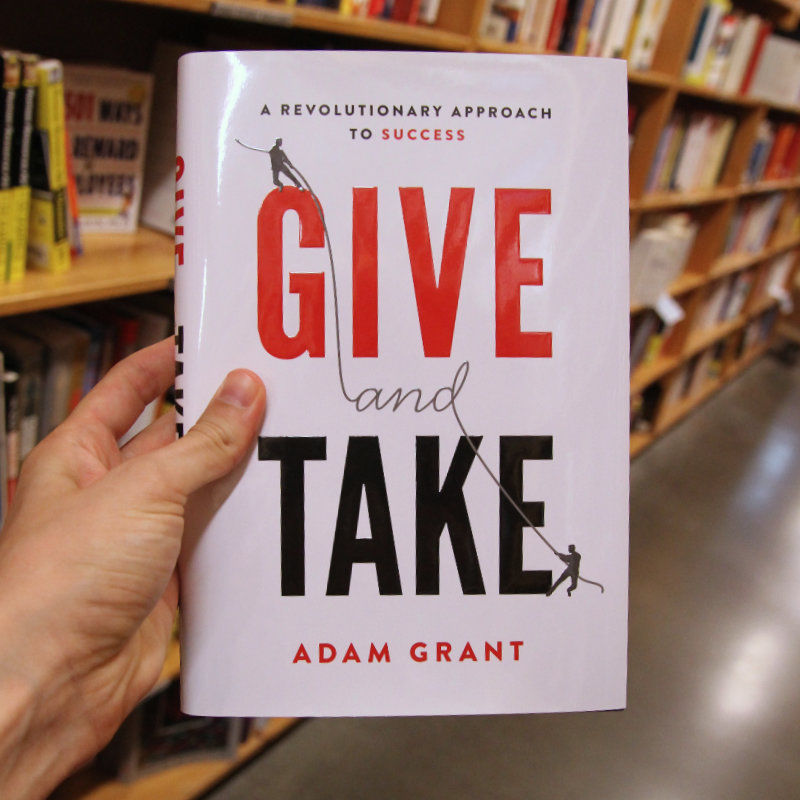Blog / 2013 / Surveying the Give and Take of Sharing Art
July 18, 2013
I just finished Adam Grant’s Give and Take, a fascinating book which aims to upend our idea that nice people finish last. In it, the author presents surprising proof that givers are more successful than matchers or takers.
The book made my brain hurt a bit as I tried to unravel what sort of person I was as well as what situations brought out what mode in me. It’s well worth a read for anyone who’s interested in gaining a better understanding of themselves, others, and business.

As I studied Give and Take, my thoughts turned to the copyright paradigm of creativity. On the one hand, it seems so normal, like viewing creativity as intellectual property is just how things should be. After all, isn’t copyright what allows artists to be successful in their careers? If artists can’t protect their rights to their work, how can they be paid for what they do? On the other hand, copyright doesn’t tend to play out that way in reality. Most creatives aren’t being paid, and, when they are, copyright has little to do with it. That’s when it dawned on me...
The idea that an artist should control all uses of their work is a taker mentality.
Or rather, that’s how I see it, but I’m curious how you see it. To figure that out, I’ve adapted part of Grant’s giver-matcher-taker assessment (which is available on his site) and what follows are two quick surveys I’d love for you to take.
SURVEY #1
Are artists who believe in copyright selfish, generous, or somewhere in between?
1. When an artist who embraces copyright shows you their work, what do they typically expect from you in return?
- That I will pay them for the pleasure of enjoying their art.
- That I will give them credit if I share their work with others.
- Nothing. There are no strings attached.
2. What types of people do artists who use copyright prefer to show their work to?
- People who are important and influential.
- People who can pay for the privilege.
- People who might most benefit from seeing the work.
3. When you interact with the work of a copyright artist, you think the artist’s primary goal is to...
- ...garner lots of attention for their work and become famous.
- ...get paid for all uses of their work.
- ...provide me with an interesting experience.
4. When you use a copyright artist’s work non-commercially and with attribution, how do they usually respond?
- They send me a cease and desist letter.
- They allow me to do so, but they remind me of copyright law and of the importance of asking for permission.
- They thank me for my interest and take the opportunity to learn more about me as a person.
5. When you remix a copyright artist’s work, how do they usually respond?
- They send me a cease and desist letter.
- They allow me to do so, but they remind me of copyright law and of the importance of asking for permission.
- They are somewhere between tickled and awed by my creation, and it energizes them.
6. Which of the following values is the most important to an artist who embraces copyright?
- Winning: doing better than others.
- Reciprocity: maintaining an even balance of giving and receiving.
- Generosity: giving as much as possible to others.
SURVEY #2
Are artists who do not claim copyright selfish, generous, or somewhere in between?
1. When an artist who renounces copyright shows you their work, what do they typically expect from you in return?
- That I will pay them for the pleasure of enjoying their art.
- That I will give them credit if I share their work with others.
- Nothing. There are no strings attached.
2. What types of people do artists who uses open licenses prefer to show their work to?
- People who are important and influential.
- People who can pay for the privilege.
- People who might most benefit from seeing the work.
3. When you interact with the work of a copyleft artist, you think the artist’s primary goal is to...
- ...garner lots of attention for their work and become famous.
- ...get paid for all uses of their work.
- ...provide me with an interesting experience.
4. When you use a copyleft artist’s work non-commercially and with attribution, how do they usually respond?
- They send me a cease and desist letter.
- They allow me to do so, but they remind me of copyright law and of the importance of asking for permission.
- They thank me for my interest and take the opportunity to learn more about me as a person.
5. When you remix a copyleft artist’s work, how do they usually respond?
- They send me a cease and desist letter.
- They allow me to do so, but they remind me of copyright law and of the importance of asking for permission.
- They are somewhere between tickled and awed by my creation, and it energizes them.
6. Which of the following values is the most important to an artist who does not believe in copyright?
- Winning: doing better than others.
- Reciprocity: maintaining an even balance of giving and receiving.
- Generosity: giving as much as possible to others.
For both surveys, the “a” answers tally up for the taker perspective, the “b” answers represent the matcher mode, and the “c” answers are the giver responses. Please share your results with me!
UPDATE
May 30, 2018
If you’re thinking that copyright might not be that great for artists, but you want to know more about it, check out my TEDx talk about imitation, this longer talk about freeing your art and yourself from copyright, or my book You Share Good.
Maybe this post made you think of something you want to share with me? Or perhaps you have a question about my art? I’d love to hear from you!
To receive an email every time I publish a new article or video, sign up for my special mailing list.
If you enjoyed this post, Ko-fi allows you to donate. Every dollar you give is worth a bajillion to me!



